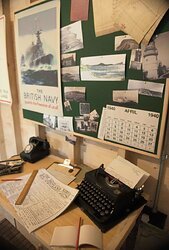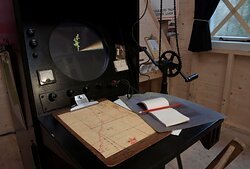Radar Hut
 8th April 1940 was a significant day for the Sumburgh Head Radar Station (image by Frank Bradford)
The significance of the radar station at Sumburgh Head cannot be overestimated. During World War II, this station was instrumental in detecting, and giving early warning, of a large scale attack on the British Home Fleet at Scapa Flow in Orkney. Had it not been for this warning provided by the radar operator on the evening of 8th April 1940, the consequences may have been grave indeed for the British Naval fleet.
8th April 1940 was a significant day for the Sumburgh Head Radar Station (image by Frank Bradford)
The significance of the radar station at Sumburgh Head cannot be overestimated. During World War II, this station was instrumental in detecting, and giving early warning, of a large scale attack on the British Home Fleet at Scapa Flow in Orkney. Had it not been for this warning provided by the radar operator on the evening of 8th April 1940, the consequences may have been grave indeed for the British Naval fleet.
The Sumburgh Head radar facility started permanent watch on 27th December 1939. Named Admiralty Experimental Station Number 1 (AES1), the station was tasked with plotting surfaced U-boats attempting to escape from the North Sea into the North Atlantic, but was also capable of detecting aircraft by transmitting and recieving radio waves. As the science and practice of radar rapidly evolved through the late 1930's, Sir James Somerville, Vice Admiral of the Royal Navy, proposed a wider network of naval stations to protect the strategically significant waters to the north of Scotland. This included stations at Dunnet Head, South Ronaldsay, Fair Isle, Unst, and later, on the north-west coast of Iceland.
Construction of the Sumburgh Head radar station began in October 1939. The receiver hut was placed just outside the southern wall of the inner enclosure of the Lighthouse buildings, whilst the transmitter hut was erected immediately adjacent to the foghorn. Both structures still survive, with the transmitter hut having been restored to re-create how it might have appeared in 1940 - with a little bit of artistic licence. Having both transmitter and recieving stations in one building allows our visitors to see the complete operation.
 The bicycle pedals you can see here were used to turn the radar array on the roof (image by Frank Bradford)
The original huts were made of wood, however were soon replaced with a more substantial shuttered concrete design. The huts were straddled by gantries which carried the aerial arrays, one for transmitting, the other receiving. Inverted searchlight turntables were used for rotation, which was carried out manually using a chain connected to an up-turned bicycle framework - with the pedals replaced by wooden handles for turning! This set-up can be seen in the re-created radar hut.
The bicycle pedals you can see here were used to turn the radar array on the roof (image by Frank Bradford)
The original huts were made of wood, however were soon replaced with a more substantial shuttered concrete design. The huts were straddled by gantries which carried the aerial arrays, one for transmitting, the other receiving. Inverted searchlight turntables were used for rotation, which was carried out manually using a chain connected to an up-turned bicycle framework - with the pedals replaced by wooden handles for turning! This set-up can be seen in the re-created radar hut.
History teacher Jon Sandison makes use of the facility to enhance the learning experience for his students when covering World War II topics. He states: "The Radar hut reminded me so much of the quality and type of interactive displays that you have at the Imperial War Museum in London. The sound of the air raid warning and the amazing display around it just puts you back in time." Journey back to 1940 and experience it for yourself on your next visit to Sumburgh Head.
To enhance your visit to Sumburgh Head and find out more about the defensive role that AES1 had during World War II, download your free copy of the Sumburgh Head At War Trail.
SUPPORT US
 |
We receive no public funding and rely entirely on the generous support of our visitors to keep the site staffed and maintained, the buildings and collections cared for and to welcome visitors through our doors. Please support us by donating now and recommending our site to your friends. |

